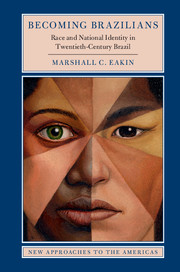Book contents
- Becoming Brazilians
- New Approaches to the Americas
- Becoming Brazilians
- Copyright page
- Dedication
- Dedication
- Contents
- Figures
- Acknowledgments
- Maps
- Introduction Creating a People and a Nation
- 1 From the “Spectacle of Races” to “Luso-Tropical Civilization”
- 2 Communicating and Understanding Mestiçagem
- 3 Visualizing Mestiçagem
- 4 “Globo-lizing” Brazil
- 5 The Beautiful Game
- 6 The Sounds of Cultural Citizenship
- 7 Culture, Identity, and Citizenship
- Epilogue Nation and Identity in the Twentieth and the Twenty-First Centuries
- Bibliography
- Index
- References
Bibliography
Published online by Cambridge University Press: 23 July 2017
- Becoming Brazilians
- New Approaches to the Americas
- Becoming Brazilians
- Copyright page
- Dedication
- Dedication
- Contents
- Figures
- Acknowledgments
- Maps
- Introduction Creating a People and a Nation
- 1 From the “Spectacle of Races” to “Luso-Tropical Civilization”
- 2 Communicating and Understanding Mestiçagem
- 3 Visualizing Mestiçagem
- 4 “Globo-lizing” Brazil
- 5 The Beautiful Game
- 6 The Sounds of Cultural Citizenship
- 7 Culture, Identity, and Citizenship
- Epilogue Nation and Identity in the Twentieth and the Twenty-First Centuries
- Bibliography
- Index
- References
- Type
- Chapter
- Information
- Becoming BraziliansRace and National Identity in Twentieth-Century Brazil, pp. 285 - 314Publisher: Cambridge University PressPrint publication year: 2017

